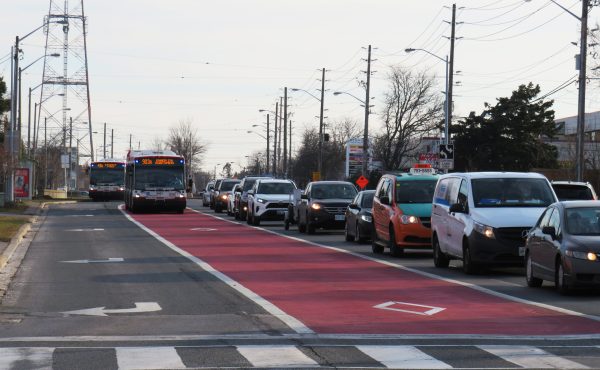According to a recent Toronto Transit Commission report, ridership across the city’s public transit system is growing at a rate “well above industry-wide trends.” Ridership is expected to reach 512 million trips this year, an increase of 38% since 1996, and well above the 503 million passengers the system is currently equipped to carry.
As overall TTC ridership grows, so does congestion underground. Toronto commuters, packed like sardines into subway cars or waiting on jammed platforms at rush-hour, are asking the obvious question: why not increase system capacity by putting more trains on the tracks? Sounds simple enough, so why doesn’t the TTC do it?
The answer is the TTC’s out-dated “fixed block” subway signaling system limits the number of trains that can be on the tracks at once. Developed in the 1950s, the system spaces out the trains in what is called a fixed block (the distance it would take, under minimum braking power, to stop a fully loaded train traveling at maximum speed) to maintain a safe buffer to operate within.
Under this system, the manually-controlled trains rely on signals similar to traditional traffic lights. Introducing additional vehicles to the system brings each train closer to its fixed block, meaning that a delay on one train will affect more of the trains behind it.
For cash-strapped transit systems like Toronto’s, converting out-dated manual signaling systems to computer-based train control (CBTC) technology offers a relatively cost-effective solution to increasing commuter capacity. For example, London’s recent Jubilee line expansion included replacing the out-dated signaling system with CBTC technology — installed by French firm Thales (which bought Canadian signaling firm Alcatel in 2006) — while increasing the line’s capacity from approximately 15 trains per hour to 50 trains. If Thales hadn’t installed the CBTC system a new tunnel would have needed to be built to accommodate the frequency of trains. The beauty of the CBTC installation (roughly $60-million) is that it accomplished the same goal as building a new tunnel (roughly $1-billion) but saved the London transit authority from building an extremely expensive capital project.
Thales has been an industry leader in global transportation technology since the 1980s, when it developed SelTrac, a CBTC system that can dramatically increase train capacity. CBTC allows transit agencies to safely modify the safety buffer for each train based on real-time data. Onboard computers installed in every vehicle send information, such as the train’s status, speed, and location, several times per second to computers located in a central control facility .
“When you look at even TTC and all of their plans, the cost and civil works of the stations are phenomenally expensive,” says Walter Kinio, Director of research, development, and product management at Thales, “our stuff is a fraction of the cost but it’s a critical component.”
The CBTC system monitors the speed of each train, alerting the operator if he or she is going too fast, and if the operator fails to reduce speed, it will apply an emergency brake. “The system reacts a lot faster than people can,” says Kinio; “It’s dynamically computing, based on data, how far that train can go before it has to apply the brakes, so you can actually put trains together more closely under dynamic conditions by continuously re-computing the safe separation distance.”
In fact, with CBTC technology human drivers could soon be a thing of the past. In the 25 years since Thales built SkyTrain for the 1986 Vancouver World Expo — the first fully automatic (driverless) transit system — the company’s technology has spread across the globe, from Dubai to Korea and Mecca to Las Vegas. Today, most of the 55 transit lines installed by Thales in 30 countries worldwide are completely driverless.
Ron Young, Director of customer care at Thales, acknowledges that many people remain apprehensive about trusting a subway full of passengers to a computer and feel safer knowing that a human is behind the wheel. His response is to point out that many of us use a driverless system every day and don’t think twice about it. “Back in the day, when elevators had people manning them, I’m sure everyone was saying the same thing — that you can’t get on an elevator without a driver. The way we look at it, driverless trains are not a lot different from the elevator you rode on here today.”
Young points to the VIA Rail derailment in Burlington last February. “There was a driver going over speed,” he says. “Again, you’re depending on the driver obeying the signals — an issue that would not arise with a system in place to monitor how fast the driver is going and automatically apply the brakes.”
The CBTC system can even increase capacity of single-track lines by alternating the direction of trains traveling on the same piece of track, says Young. “You would never dream of doing that with a manual system: running trains in opposite directions on the same piece of track. But with an automatic system, it’s easy. You time co-ordinate it and it’s all controlled safely.”
And for transit users all too familiar with the frustrating delays that often go hand in hand with construction projects to improve service, the installation of automated signaling systems comes with another bonus: it doesn’t disrupt service. “There is no shutting down the system for two months. We have to go into some of these systems, like Jubilee, that run 24 hours a day, and install our equipment, test it, commission it and cut over to our system,” says Young “You’re literally changing the motor of your car as you drive along.”
![]()
On March 30, 2012 the Toronto Transit Commission approved a report that recommends awarding a contract to Ansaldo STS Canada Inc., to design, supply, and install a signal system on the Yonge University Spadina (YUS) Line (Phases 2, 3 and 4) and on the Toronto York Spadina (TYS) Subway Extension. Re-signaling the YUS and TYS lines, using automatic train control technology, will improve the safety, capacity, operating efficiencies and cost effectiveness of both lines.
Photo by Harshil Shah





9 comments
An increase of 38% in ridership since 1996. Unacceptable! Rob Ford ordered a 10% cut in services, which included the TTC. There should be at least a 10% reduction in ridership, instead we get increases. The TTC may have to reverse its service cuts made during Rob Ford regime, and return to the service levels of before, or worse increase TTC services. We can’t do that and please Rob Ford at the same time, can we?
Thales is actually a French multinational, not Canadian.
While resignaling the system will certainly help increase the number of possible trains per hour, the capacity will still be limited by the arrangement of terminals/crossovers at the end of each line and also by dwell times at busy stations, notable Yonge/Bloor. Steve Munro has discussed this in great detail in the past on his blog: http://stevemunro.ca/?p=4485
The example cited for London is misleading when applied to Toronto on two counts. First, the existing system in Toronto can handle close to 30 trains per hour although constraints at a few locations make the practical limit about 28. A burst of trains at a rate better than one every 120 seconds is possible, but when they hit one of the constrained areas (notably terminals) there is a backup.
Second, a rate of 50 trains/hour cannot be sustained if the trains have to actually stop and serve a station platform. This rate only works for a shared track where services branch before they actually try to serve stations.
The TTC needs a new signal system on the Yonge line, but it has oversold the capacity improvements possible with new signals and trains (partly to drum up funding for a “solution” that is more about maintenance). Finally, a new generation of TTC management is looking to a parallel line (the DRL or whatever we call it) to add substantial new capacity into the core.
The new signals on YUS will bring some improvements especially when the line has minor delays that would today cascade into queues of trains, but they will not provide a massive increase in line capacity on the scale implied by this article.
Boy, that photo reminds me of how sexy that 30s London Underground streamlining is.
Aaah, thanks, Steve, for knowing so much and un-misleading us all once again 🙂
Make Eglinton a proper subway line (with elevated sections in the outer ends), not a light rail line.
Using light rail to save money means that there is a high risk that the Eglinton light rail line will become overcrowded. Eglinton will be the main route across the city north of downtown, a significant alternative to Highway 401 and the main access to the Pearson airport area in Mississauga (where a very large number of people work, the 2nd largest employment area in the GTA after downtown). As Toronto grows and the areas along Eglinton Avenue become more densely populated, building a line that has 1/2 the capacity of Highway 401 and 1/4 the capacity of the Bloor-Danforth line (in the surface sections) means that there is a high risk that it will become severely overcrowded in rush hour. Eglinton has a high risk of becoming the busiest light rail line in the world, as many people who currently use the congested 401, many of them commuting back and forth between Toronto and Mississauga, switch to using the Eglinton LRT+buses. It is very unusual to build a light rail line with a long underground tunnel section, as light rail really only makes sense in low density areas/smaller cities on routes with low demand where it runs entirely on the surface (such as the light rail line proposed in Kitchener). In a city like Vancouver the Eglinton LRT would have been an automated subway, with elevated sections in areas like Golden Mile and Richview, and would have much higher capacity than LRT.
If Eglinton is built as light rail, there is a high probability that an expensive upgrade project will be needed to convert it to a proper subway in the future. Why did the builders of the existing subway system have the foresight to built a system with lots of spare capacity (the existing subway was far less busy when it first opened than it is now) while we are now too cheap to plan for the capacity we need 20 or 50 years in the future?
@Adam Sobolak: It’s not ’30s streamlining. It’s the size of tunnels built in the late 19th century that dictates the size and shape. (Although the Jubilee line dates from the mid ’70s and late ’90s, and the rolling stock in that photo isn’t a decade old…)
The figures for London’s Jubilee Line in this article are incorrect. The new signalling has increased peak capacity from 22-24tph to 28-30tph, with future capability of 33tph.